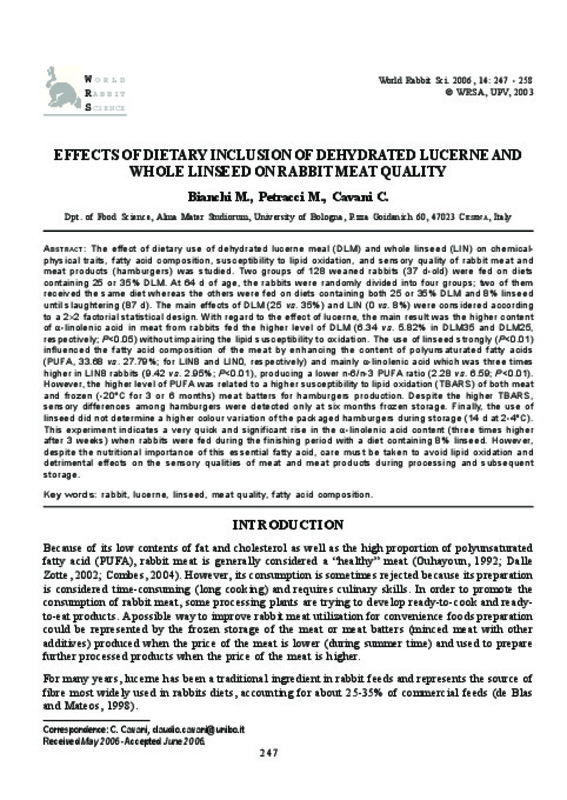JavaScript is disabled for your browser. Some features of this site may not work without it.
Buscar en RiuNet
Listar
Mi cuenta
Estadísticas
Ayuda RiuNet
Admin. UPV
Effects of dietary inclusion of dehydrated lucerne and whole linseed on rabbit meat quality
Mostrar el registro sencillo del ítem
Ficheros en el ítem
| dc.contributor.author | Bianchi, M.
|
|
| dc.contributor.author | Petracci, M.
|
|
| dc.contributor.author | Cavani, C.
|
|
| dc.date.accessioned | 2011-02-09T10:08:12Z | |
| dc.date.available | 2011-02-09T10:08:12Z | |
| dc.date.issued | 2006 | |
| dc.identifier.issn | 1257-5011 | |
| dc.identifier.uri | http://hdl.handle.net/10251/9562 | |
| dc.description.abstract | [EN] The effect of dietary use of dehydrated lucerne meal (DLM) and whole linseed (LIN) on chemicalphysical traits, fatty acid composition, susceptibility to lipid oxidation, and sensory quality of rabbit meat and meat products (hamburgers) was studied. Two groups of 128 weaned rabbits (37 d-old) were fed on diets containing 25 or 35% DLM. At 64 d of age, the rabbits were randomly divided into four groups; two of them received the same diet whereas the others were fed on diets containing both 25 or 35% DLM and 8% linseed until slaughtering (87 d). The main effects of DLM (25 vs. 35%) and LIN (0 vs. 8%) were considered according to a 2x2 factorial statistical design. With regard to the effect of lucerne, the main result was the higher content of a-linolenic acid in meat from rabbits fed the higher level of DLM (6.34 vs. 5.82% in DLM35 and DLM25, respectively; P<0.05) without impairing the lipid susceptibility to oxidation. The use of linseed strongly (P<0.01) influenced the fatty acid composition of the meat by enhancing the content of polyunsaturated fatty acids (PUFA, 33.68 vs. 27.79%; for LIN8 and LIN0, respectively) and mainly a-linolenic acid which was three times higher in LIN8 rabbits (9.42 vs. 2.95%; P<0.01), producing a lower n-6/n-3 PUFA ratio (2.28 vs. 6.59; P<0.01). However, the higher level of PUFA was related to a higher susceptibility to lipid oxidation (TBARS) of both meat and frozen (-20°C for 3 or 6 months) meat batters for hamburgers production. Despite the higher TBARS, sensory differences among hamburgers were detected only at six months frozen storage. Finally, the use of linseed did not determine a higher colour variation of the packaged hamburgers during storage (14 d at 2-4°C). This experiment indicates a very quick and significant rise in the a-linolenic acid content (three times higher after 3 weeks) when rabbits were fed during the finishing period with a diet containing 8% linseed. However, despite the nutritional importance of this essential fatty acid, care must be taken to avoid lipid oxidation and detrimental effects on the sensory qualities of meat and meat products during processing and subsequent storage. | es_ES |
| dc.description.sponsorship | The authors are grateful to “F.lli Martini & C. S.p.A.” for technical assistance. Research founded by MIUR - PRIN ex 40%. | |
| dc.language | Inglés | es_ES |
| dc.publisher | World Rabbit Science. ICTA. UPV | es_ES |
| dc.relation.ispartof | World Rabbit Science | |
| dc.rights | Reserva de todos los derechos | es_ES |
| dc.subject | Rabbit | es_ES |
| dc.subject | Lucerne | es_ES |
| dc.subject | Linseed | es_ES |
| dc.subject | Meat quality | es_ES |
| dc.subject | Fatty acid composition | es_ES |
| dc.title | Effects of dietary inclusion of dehydrated lucerne and whole linseed on rabbit meat quality | es_ES |
| dc.type | Artículo | es_ES |
| dc.date.updated | 2011-02-09T08:35:13Z | |
| dc.identifier.doi | 10.4995/wrs.2006.562 | es_ES |
| dc.rights.accessRights | Abierto | es_ES |
| dc.description.bibliographicCitation | Bianchi, M.; Petracci, M.; Cavani, C. (2006). Effects of dietary inclusion of dehydrated lucerne and whole linseed on rabbit meat quality. World Rabbit Science. 14(4). https://doi.org/10.4995/wrs.2006.562 | es_ES |
| dc.description.accrualMethod | SWORD | es_ES |
| dc.relation.publisherversion | https://doi.org/10.4995/wrs.2006.562 | es_ES |
| dc.description.volume | 14 | |
| dc.description.issue | 4 | |
| dc.identifier.eissn | 1989-8886 | es_ES |
| dc.contributor.funder | Ministero dell'Istruzione dell'Università e della Ricerca, Italia |








